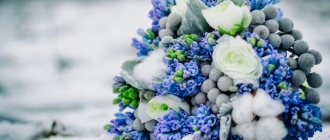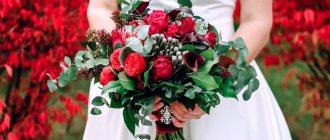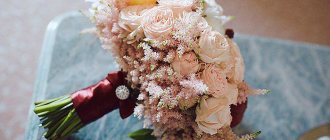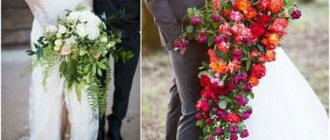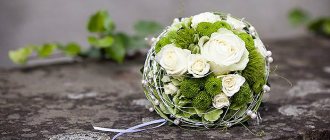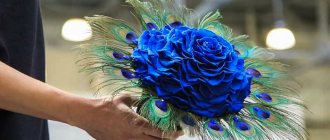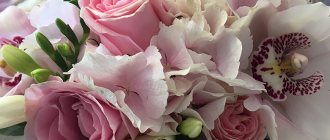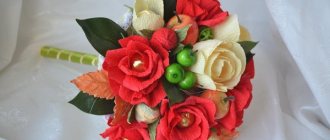The cream color is close to white, and may have a beige or pink tint. Cream roses were born thanks to the efforts of Chinese florists in the 18th century. Soon this amazing variety came to the UK, where it immediately gained popularity. A bride's bouquet of cream roses symbolizes sincere relationships, hopes come true and dreams come true.
The cream shade is close to white, related to creamy and milky colors, as well as shades of ivory and champagne.
What outfit does it go with?
Cream color combines with warm shades of pink and green, bright red tones, orange and yellow. Contrasts with cool tones of blue, purple and green. Looks good in combination with brown and neutral gray.
The bride's cream bouquet fits well with a romantic look: relaxed hairstyle, natural makeup, dress made of light fabrics. When choosing an outfit, you should abandon strict crinolines and pay attention to multi-layered skirts that look airy and natural.
Another type of wedding where pastel shades are indispensable is the vintage style. A wedding of this concept requires soft combinations and muted accents, retro-style outfits and a themed photo shoot. For the ceremony, it is better to choose a powder or pearl-colored lace dress.
A wedding bouquet of cream roses goes well with floor-length dresses and short dresses with a long train. For a rustic wedding, you can choose a floral wreath as a veil. Cream shades go well with the groom's formal attire. The main thing is that the fabric of the suit is not shiny.
Attention! We have collected other beautiful wedding compositions in pastel colors in this article.
A boutonniere can be created from a small bush rose of a beige or pinkish hue. For an outdoor wedding, a suit without a jacket is suitable. The banquet hall is decorated in subdued colors. Roses can be used to decorate floral arrangements and vases on tables. The arch can be decorated with flowers or created from light flowing fabric.
Original bouquets of peonies and roses
Roses and peonies can be perfectly combined, because they have lush buds and a rich range of colors. Moreover, a bride's bouquet of these flowers symbolizes wealth and youth.
The cream shade can be combined with peach, pink, and beige. If you want to add some zest to the bouquet, add a bright color - blue, purple.
KNOWLEDGE BASE: Tips for organizing a budget outdoor summer wedding
Mono option
The classic bridal bouquet in cream tones, the photo of which is above, is made of cream roses and eucalyptus. Greenery highlights the tenderness of the buds. In addition to eucalyptus, the bouquet is expressive when interspersed or framed with other greenery: salal, aspidistra, ruscus, fern. You can dilute the composition with the usual gypsophila.
With flowers of similar colors
Cream roses can also be combined with other varieties of roses. Bombastic bush roses with tightly twisted buds set off large flowers and become a highlight.
French Norma Jean roses have a similar shade with an amazing aroma and unusual shape of petals. Close to the creamy shade of the ivory Ritz rose. French hybrid roses Creme Piegé have a delicate white-cream color.
Their peony buds go well with cream roses. The milky shade of David Austin roses is distinguished by an unusual cup-shaped bud shape. Compositions in a dim palette are decorated with greenery and flowers in brighter shades, such as pink. The result is a delicate bouquet for a classic European-style wedding.
With bright buds
Cream color is not an active representative of the color palette. Bright buds can outshine the delicate creamy shade. Therefore, to maintain balance, flowers of ruby hues are added carefully. A few red roses or dahlias are enough.
With warm shades
Gerberas, alstroemerias, chrysanthemums and peonies in yellow tones add sunny warmth to the bouquet. At the same time, the combination with cream color looks organic. The dress for such a bouquet can be either traditional white or have a yellowish tint.
With blue and purple plants
When choosing blue and lilac colors, the main thing is not to overdo it and maintain balance. A light dress can be set off with some shade of blue or purple: this can be a belt or shoes. One accent is enough.
Interesting! A custom bridal bouquet in cream tones will be created by adding freesias or irises.
Unusual combinations
Roses are successfully combined with dried flowers and cotton. This bouquet suits the bride's look for a rustic wedding. You can decorate the bouquet with cinnamon sticks, craspedia, physalis, mordovnik, and succulents. Wildflowers are suitable for young brides, emphasizing youth and spontaneity.
Elegant solutions
An exotic combination can be achieved with the help of sophisticated Cymbidium orchids. Beige or milky calla lilies will add austerity to the look. Such compositions are usually chosen by brides over 30.
Unusual cream bouquet
We bring to your attention an interesting version of a cream bouquet in the European style using a non-standard wedding find - a spikelet of matthiolla.
Editor's Choice: The best ways to surprise your wedding guests. Photo review
This flower on a long stem has an interesting spring aroma with a bitter taste, but in combination with roses it turns out very tasty.
You will need:
- cream mattiolla (levkoy);
- light cream rose;
- European round bouquet holder.
To give roses dominance in the composition, shorten the long flower stem of Matthiolla by half, as shown in the picture.
The thin stem of the mattiolla will allow it to hang slightly over the edges of the holder, giving the bouquet smooth soft outlines. This is also a natural way to disguise the foamiran parts of the bouquet base.
Continue arranging the bouquet, leaving the roses in the center and placing the mattiolla mainly at the edges.
The result is a stylish, neat cream bouquet.
How to decorate
Roses themselves are expressive. They do not require extensive finishing. A simple satin ribbon or two ribbons of similar shades is enough.
Round bouquets with short legs and flowing edges of ribbons are created from cream roses. These are resistant plants.
When cut, they remain fresh for up to two weeks, which cannot be said about white flowers, the petals of which darken quite quickly after cutting. This is why florists usually do not attach roses to a porta bouquet. Oasis can be used if roses are combined with unstable plants. At the same time, it is important that the porta bouquet is well camouflaged, because the edges of the base showing through are bad form.
If desired, the bouquet can be decorated with beads or stasis. It should be remembered that the more abundant the trim on the dress, the less there should be on the bouquet. Small bouquets go with fluffy skirts. For a dress with a straight silhouette, you can choose a voluminous bouquet, for example, a flowing one.
The decoration of the bouquet depends on the style of the wedding:
- burlap - for a country style ceremony;
- satin for a classic wedding, sisal for a seasonal celebration;
- lace - for a romantic wedding.
Spring bridal bouquet
Spring is one of the most beautiful moments of the year. The time of birth of new life, optimism, happiness, prosperity and hope. The bride's spring bouquet reflects all these emotions in buds and inflorescences. What are the most popular spring wedding flowers? Let's make the TOP-10.
1. Peonies
How do spring peonies differ from winter peonies? Firstly, the price. Winter peonies, when they are brought to us from Chile, will cost you a pretty penny. But starting in April, prices for peonies will begin to go down a little, and in May you will be able to use peonies at your wedding without worrying so much about your budget.
Secondly, the variety of colors. White, pink, fuchsia, coral, burgundy, wine, red and bright lemon, densely double and with only one row of petals. The choice of peonies in mid-spring is so wide that it is almost a crime to refuse them. Especially if you are planning a wedding with your own hands - the splendor of the inflorescences will make it easy to create compositions on the guests’ tables!
2. Lilac
To be fair, lilacs are commercially available from November to May, but their natural flowering period is spring. Delicate, attractive with a tempting aroma and fluffy inflorescences, white, pink, lilac and purple branches are a very delicate and romantic flower for a wedding. Of course, it is quite capricious and does not really like to be without water for a long time, but lilac is so good that it is worth the risk.
3. Tulips
The symbol of March 8, the tulip is undeservedly in the shadow, like carnations, which seem too banal to many. The whole point of a tulip is that it is practically a symbol of spring. Even after being cut, the tulip continues to grow, reaching towards the sun. Therefore, if you have chosen a bouquet of tulips, you should not pick it up from the florist the day before. Overnight, flowers can grow in a chaotic direction, making their own adjustments to the shape of the bouquet.
4. Daffodils
White, sunny yellow, mustard, lemon, tangerine, large, small bush, double - daffodils are so life-affirming and graceful that they can rightfully be considered one of the brightest representatives of spring flowers. They, like many bulbous plants, secrete juice that is destructive to other flowers. But with proper preparation, everything can be leveled out.
5. Hyacinths and muscari
Hyacinths and muscari are relatives. The second name for muscari is mouse hyacinth. These plants are known to many as potted plants. The second symbol of International Women's Day after tulips. These flowers are especially beautiful because they have blue and cyan shades, so valuable in floristry, since the number of true blue flowers in nature is quite limited.
6. Hydrangea
In spring, the first delicate hydrangeas appear: sky blue, light pink, powdery lavender. Hydrangea is an amazing flower. The longer the hydrangea bush blooms, the more saturated the colors become. Over time, blue turns into rich blue, light pink into fuchsia, and lavender into deep purple. Hydrangea is the same capricious lady as lilac. Even more. Using it without water is not only not recommended, but simply prohibited.
7. Lilies of the valley
Do not think that now we will talk about those lilies of the valley that are listed in the Red Book. Commercial lilies of the valley have special certificates and also vary in color: white and pink. Lilies of the valley are only 20-25 cm in height, so their use is quite limited. They come as small bushes along with roots; they can be planted in flowerpots and taken home after the celebration, so that they will delight you throughout their flowering period.
8. Snowdrops
Inextricably linked in the minds of many with the fairy tale “12 months”. These delicate little bells are the embodiment of the first steps of spring, because they are one of the first to appear from under the snow, signaling the arrival of spring and the retreat of winter. These flowers, like many spring flowers, are quite fragile, which makes them quite difficult to use in bouquets.
9. Viburnum
Or simply viburnum. The lime-green spherical inflorescences of this tree are often used in floristry. The texture of viburnum is quite close to hydrangea, but more elegant. Viburnum blooms in nature in April-May; as a cut flower it is available almost all year round, but the price is often high.
10. Ranunculus
Another flower that came to us from winter. Ranunculus, with its rich hues and abundance of weightless petals, has been a favorite among brides over the past few years. However, its flowering period ends at the end of April, and at the same time the variety of shades disappears. Starting in May, the use of ranunculus in wedding celebrations should be questioned. The closer the end of flowering, the worse the quality of the flower going on sale.
Stylish zigzags in wedding design
Decor in rustic style: making a bag (part 2). Let's decorate.
Golden wedding elements
Autumn paraphernalia for a wedding photo shoot
Wedding in pastel colors - decor ideas
Protea of your dreams (Julia and Dima)
First flowers
True, to collect such a spring wedding bouquet, you will most likely have to go to the countryside. But spring greens can be found just a stone's throw from the house, for example, lilacs, and buttercups are sold in any flower shop. Snowdrops and similar scyllas appear in forests and fields in early spring. These plants are not afraid of frost, snow, or temperature changes.
What wildflowers can you use to make a spring wedding bouquet? Photos of some composition options are above, but also pay attention to:
- hellebore;
- Erantis;
- primrose (primrose);
- crocus;
- lungwort;
- periwinkle,
- adonis (adonis);
- violet;
- liverwort;
- muscari;
- white flower;
- iridodictium;
- anemone;
- hyacinth;
- forget-me-not;
- wild tulip;
- narcissus.
Color spectrum
The main colors that spring wedding bouquets for the bride should have are pink, cream, white, lilac, blue, yellow.
With the help of plants of such shades you can create a discreet, romantic or cheerful rainbow bouquet.
Muted shades combine well with the dim early spring sun. Compositions in cream and white colors suit a delicate look.
By mid-spring, the color saturation increases, yellow-pink combinations appear. And at the end of spring you can have a wedding with a colorful bouquet of wildflowers.
